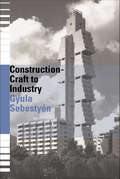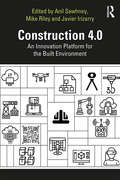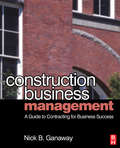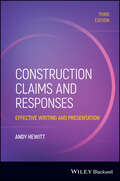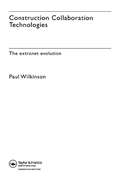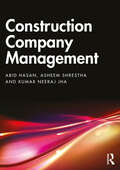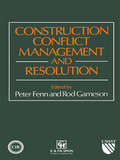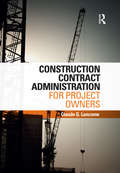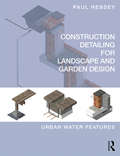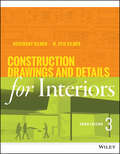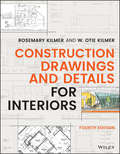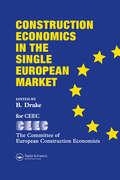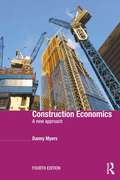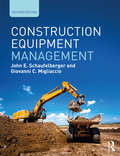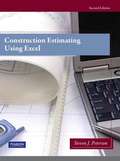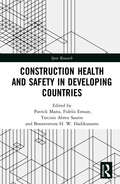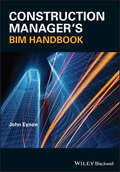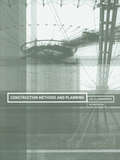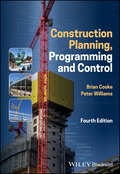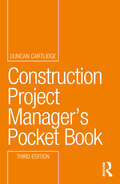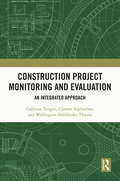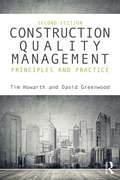- Table View
- List View
Constructing the Viennese Modern Body: Art, Hysteria, and the Puppet (Studies in Art Historiography)
by Nathan J. TimpanoThis book takes a new, interdisciplinary approach to analyzing modern Viennese visual culture, one informed by Austro-German theater, contemporary medical treatises centered on hysteria, and an original examination of dramatic gestures in expressionist artworks. It centers on the following question: How and to what end was the human body discussed, portrayed, and utilized as an aesthetic metaphor in turn-of-the-century Vienna? By scrutinizing theatrically “hysterical” performances, avant-garde puppet plays, and images created by Oskar Kokoschka, Koloman Moser, Egon Schiele and others, Nathan J. Timpano discusses how Viennese artists favored the pathological or puppet-like body as their contribution to European modernism.
Construction - Craft to Industry
by Gyula SebestyenThis book provides a unique and comprehensive survey of changes and trends in the construction industry focusing on the post-war years and emphasizing their contemporary and future relevance.
Construction 4.0: An Innovation Platform for the Built Environment
by Michael Riley Anil Sawhney Javier IrizarryModelled on the concept of Industry 4.0, the idea of Construction 4.0 is based on a confluence of trends and technologies that promise to reshape the way built environment assets are designed, constructed, and operated. With the pervasive use of Building Information Modelling (BIM), lean principles, digital technologies, and offsite construction, the industry is at the cusp of this transformation. The critical challenge is the fragmented state of teaching, research, and professional practice in the built environment sector. This handbook aims to overcome this fragmentation by describing Construction 4.0 in the context of its current state, emerging trends and technologies, and the people and process issues that surround the coming transformation. Construction 4.0 is a framework that is a confluence and convergence of the following broad themes discussed in this book: Industrial production (prefabrication, 3D printing and assembly, offsite manufacture) Cyber-physical systems (actuators, sensors, IoT, robots, cobots, drones) Digital and computing technologies (BIM, video and laser scanning, AI and cloud computing, big data and data analytics, reality capture, Blockchain, simulation, augmented reality, data standards and interoperability, and vertical and horizontal integration) The aim of this handbook is to describe the Construction 4.0 framework and consequently highlight the resultant processes and practices that allow us to plan, design, deliver, and operate built environment assets more effectively and efficiently by focusing on the physical-to-digital transformation and then digital-to-physical transformation. This book is essential reading for all built environment and AEC stakeholders who need to get to grips with the technological transformations currently shaping their industry, research, and teaching.
Construction Business Management: What Every Construction Contractor, Builder And Subcontractor Needs To Know (Rsmeans Ser. #67)
by Nick B. GanawayOnly 43 per cent of U.S. construction firms remain in business after four years. Why? Inadequate management, according to the U.S. Small Business Administration. This is surprising because most construction firms are formed by ambitious construction project managers, executives and tradesmen who have excelled at what they have been doing. But as experienced as these entrepreneurs may be, they are not likely prepared to take on the full range of responsibilities forced on them in managing the business of construction in its entirety.While this business failure rate and its causes are based on U.S. experience, available data from a number of other industrialized countries shows they are similar.This book describes in detail what the business side of the construction equation requires of the construction firm owner. The contractor who quickly learns these requirements can identify and avoid or manage around the pitfalls that cause the high failure rate in our industry and put his or her construction firm on a level playing field with the best-run companies in the business. The detailed duties of the owner, whether in the U.S., U.K., Australia or Canada, are a common theme throughout the book. The author, Nick Ganaway, speaks peer-to-peer, and the book is sprinkled with supporting examples from his own experience. He is immersed in the industry and this book is "based on the things I've learned, used, and refined as a light-commercial general contractor in the course of starting and operating my own construction firm for 25 years." The contractor doing $5 million or $50 million or more in annual sales or the equivalent amount in other countries, or the entrepreneur who is just starting up, can use the tried and proven material in this book to build a business that is profitable, enjoyable, and enduring.Additionally, the book devotes a chapter to specializing in chain-store construction.
Construction Claims and Responses: Effective Writing and Presentation
by Andy HewittThe latest and most up-to-date edition of the best hands-on guide to construction claims and claims response preparation In the newly revised third edition of Construction Claims and Responses: Effective Writing and Presentation, renowned construction claims and disputes consultant Andy Hewitt delivers yet another authoritative and practical discussion of how to prepare and respond to construction claims. Covering a variety of different types of claims – including variations, extensions of time, and additional payment – the book demonstrates an effective step-by-step process of building up a claim by breaking it down into manageable sections: contract details, causes, effects, entitlement, and quantum. You’ll find worked examples of typical claims, complete with sample wording, as well as updated and simplified examples of responses, additional detail on cost calculations, and updates to material to maintain compliance with FIDIC 2017. Readers will also discover: A thorough introduction to properly constituted and presented claims, including the establishment of contractual entitlement and comprehensive documentationComprehensive explorations of what constitutes sufficient cause and effect for a construction claimRevised and clarified worked examples of commonly made construction claims and responsesComplete discussions of accurate quantum calculations Perfect for all construction project personnel around the world involved in the preparation of construction claims, Construction Claims and Responses will also benefit those preparing responses to such claims, as well as quantity surveyors, contracts managers, project managers, claims consultants, commercial managers, engineers, architects, and adjudicators.
Construction Collaboration Technologies: An Extranet Evolution
by Paul WilkinsonSince the late 1990s, web-based collaboration technologies (‘project extranets’) have become increasingly widely used within the UK construction industry and are now routinely deployed on the design and construction of thousands of projects. The first book dedicated to the topic, this comprehensive guide will help current and future construction professionals understand, implement and use such systems more effectively. Cutting through the hype and jargon, it offers expert advice and guidance from an industry insider on choosing a software provider, key software features, hosting, legal issues, connectivity, achieving user buy-in and assessing the benefits.
Construction Company Management
by Kumar Neeraj Jha Abid Hasan Asheem ShresthaConstruction Company Management will give readers a detailed understanding of the critical aspects of managing a successful construction company in a dynamic and complex construction business environment characterised by intense competition, supply chain disruptions, and rapid changes in technology, regulations, client preferences, and market conditions.The book will introduce readers to different dimensions of construction company management. The topics covered reflect current business practices in the construction industry, including company strategy and business models, stakeholder management, contract management, resource management, risk management, knowledge management, company finance, digital innovation, organisational resilience, and the regulatory environment. The book also includes much-needed discussions on ethics, integrity and professional standards, and diversity, equity, and inclusion in construction companies. It explores the opportunities and challenges relevant to construction company management in global contexts with the help of case studies from different regions of the world.Providing a concise book on this essential subject, Construction Company Management serves both students and those educators who teach it in their built environment courses. Practitioners will find the theory-informed company management practices discussed in the book valuable and useful in their practical contexts.
Construction Conflict Management and Resolution: An International Perspective (Cib Ser.)
by P. Fenn R. GamesonThis book brings together over 40 papers presented at the 1992 International Construction Conflict Management & Resolution Conference held in Manchester, UK. Six themes are covered, including alternative dispute resolution, conflict management, claims procedures, litigation and arbitration, international construction, and education and the future.With papers from arbitrators, architects, barristers, civil engineers, chartered surveyors and solicitors, this book represents the first multi-disciplinary body of knowledge on Construction Conflict and will act as a unique source of reference for both legal and construction professionals.
Construction Contract Administration for Project Owners
by Claude G. LancomeConstruction Contract Administration for Project Owners is aimed at public and private owners of real estate and construction projects. The book is intended to assist owners in their contractual dealings with their designers and their contractors. Most owners are not primarily in the business of designing and building facilities. The fact that their primary business is not design and construction places them at a disadvantage when negotiating, drafting, and administering design agreements and construction contracts because their designers and contractors use these documents every day. This book is intended to assist owners to redress this imbalance by equipping owners to draft and administer contracts so as to protect their interests. The book is aimed at owner personnel with all levels of knowledge in the business of managing projects. It can serve as a comprehensive introduction to drafting and administering design agreements and construction contracts for beginners. For intermediate level personnel, it can serve as a manual to be read to enhance the reader’s skills in this area. For the sophisticated project management professional, it can serve as a resource to be consulted in connection with very specific issues as they arise on a project.
Construction Detailing for Landscape and Garden Design: Surfaces, steps and margins
by Paul HenseyDesigns for gardens and landscapes need to contain accurate information to ensure that both the designer’s intent is clear and to enable the highest quality constructions. This book contains the elements most often used when detailing surfaces, with key information on standards, guidance and construction that the practitioner must be aware of. Alongside the text are 2D and 3D images with suggestions of measurements, design considerations and materials. Key topics covered in this book are: Vehicular paving Pedestrian paving and patios Steps and ramps Margins, edges and kerbs Drainage channels To be used in conjunction with the book is an innovative online library of freely downloadable CAD (SketchUp format) details which link directly to those in the book. These details are available for the reader to edit, adapt and use in their own designs - and make the task of detailing for projects that little bit easier.
Construction Detailing for Landscape and Garden Design: Urban Water Features
by Paul HenseyFollowing on from the author’s previous book, Construction Detailing for Landscape and Garden Design: Surfaces, Steps and Margins, this book, Construction Detailing for Landscape and Garden Design: Urban Water Features, provides clear instruction for the construction of small to medium scale water features. With over 130 black and white CAD designs, Hensey provides guidance on a range of different water features such as drainage, water bowls and containers, walls and edges, structures and crossings, and rills, channels and cascades. This book offers technical references and a general knowledge of the basic principles, materials and techniques needed when engineering with water. This practical guide would be beneficial for garden designers and landscape architects seeking accessible and relatable materials for designing water features.
Construction Drawings and Details for Interiors: Basic Skills
by W. Otie Kilmer Rosemary KilmerConstruction Drawings and Details for Interiors serves as the essential reference for designers preparing interior construction documents, explaining how to do a new construction, remodeling, or installation project. In a highly visual format, the book covers drafting fundamentals and conventions; drawing types, plans, and schedules; and computer-aided design (CAD). With expanded coverage of the preparation and communication of construction documents in digital formats, drawing interior perspectives, and more, the text also serves as an invaluable study reference for the contract documents section of the NCIDQ exam. A new companion Web Site supplies template grids for schedules and contract documents for practice exercises.
Construction Drawings and Details for Interiors: Basic Skills
by W. Otie Kilmer Rosemary KilmerConstruction Drawings and Details for Interiors serves as the essential reference for designers preparing interior construction documents, explaining how to do a new construction, remodeling, or installation project. In a highly visual format, the book covers drafting fundamentals and conventions; drawing types, plans, and schedules; and computer-aided design (CAD). With expanded coverage of the preparation and communication of construction documents in digital formats, drawing interior perspectives, and more, the text also serves as an invaluable study reference for the contract documents section of the NCIDQ exam. A new companion Web Site supplies template grids for schedules and contract documents for practice exercises.?
Construction Drawings and Details for Interiors: Basic Skills
by W. Otie Kilmer Rosemary KilmerCONSTRUCTION DRAWINGS AND DETAILS FOR INTERIORS DISCOVER FOUNDATIONAL CONCEPTS AND THE LATEST DEVELOPMENTS IN INTERIOR CONSTRUCTION DOCUMENTS In the newly revised Fourth Edition of Construction Drawings and Details for Interiors, distinguished interior design professors Rosemary Kilmer and W. Otie Kilmer deliver a comprehensive and practical perspective on the preparation and understanding of construction documents. The authors use a highly visual presentation and offer extensive sample drawings and details, as well as photographs, to show readers the fundamentals of drafting, drawing types, plans, and schedules, and computer-aided design. The Fourth Edition includes new sections on contract administration, field measuring tools, safety and security, and smart systems and controls. A companion website offers PowerPoint lecture slides, an instructor’s manual, activities, test questions, and solutions. New appendices feature examples of interior design projects and common symbols for construction drawings. The book also includes: A thorough introduction to drawing communication, equipment, and classification systems, including information about Building Information Modeling and building certification programs for sustainability A discussion of green building certification programs An exploration of the design process, including concept development, hand sketching, design development, preliminary designs, sketches, and presentations A practical review of contract documents, including specifications, contracts, construction drawings, as-built drawings and demolition plans, and floor plans An in-depth examination of structural, mechanical, and plumbing systems Construction Drawings and Details for Interiors is perfect for interior design students, early-career professionals hoping to improve their understanding of project drawing conventions, or anyone studying for the NCIDQ exam.
Construction Economics in the Single European Market
by B. DrakeConstruction Economics in the Single European Market is an edited selection of papers from the first European Construction Economics Conference. Experts give details on construction costs from many European countries including Denmark, Ireland, France, Sweden, Netherlands, Spain and the UK.
Construction Economics: A New Approach
by Danny MyersConstruction Economics provides students with the principles underlying the relationship between economic theory and the construction industry. Its new approach specifically examines the problems of securing sustainable construction. The new edition has been fully revised to provide an overview of the economy and construction markets since the global financial crisis. As such it examines the challenges of changing government policy, adapting to climate change, adopting BIM, and reducing costs. A new introduction along with new readings, data, examples, glossary items, government strategies, and references, revises this established core text and brings it up to the historic EU referendum. As with previous editions, it retains a tried and tested format: a clear and user-friendly style use of a second colour for emphasis regular summaries of key points a glossary of construction economics extensive use of tables and figures extracts from Construction Management and Economics reviews of useful websites. This invaluable textbook is essential reading across a wide range of disciplines from construction management and civil engineering to architecture, property and surveying.
Construction Equipment Management
by John E. Schaufelberger Giovanni C. MigliaccioThis revised and updated edition of Construction Equipment Management fills a gap on this subject by integrating both conceptual and hands-on quantitative knowledge on construction equipment into a process that facilitates student learning. The first six chapters summarize interdisciplinary concepts that are necessary to ground students' learning on construction equipment management, including both engineering and economics. Each of the next 16 chapters covers a different type of construction equipment and associated methods of use. The final chapter introduces the more advanced concept of operation analysis. This allows the book to be used on numerous courses at different levels to prepare graduates to apply skills on construction equipment when planning for a new project, estimating its costs, and monitoring field operations. Organized around the major categories of construction equipment, including both commercial and heavy civil examples, case studies, and exercises, this textbook will help students develop independence in applying concepts to hands-on scenarios. A companion website provides an instructor manual, solutions, additional examples, lecture slides, figures, and diagrams.
Construction Estimating Using Excel Second Edition
by Steven J. PetersonConstruction Estimating with Excel, Second Edition, introduces readers to the fundamental principles of estimating. Using drawing sets, real-world exercises, and examples, the text offers students critical estimating experience. The book moves step-by-step through the estimating process, discussing the art of estimating, the quantity takeoff, how to put costs to the estimate, and how to finalize the bid. As students progress through the text they are shown how Microsoft Excel can be used to improve the estimating process. Because it introduces spreadsheets as a way of increasing estimating productivity and accuracy, the book can help both beginning and experienced estimators improve their skills.
Construction Health and Safety in Developing Countries (Spon Research)
by Fidelis Emuze Patrick Manu Tarcisio Abreu Saurin Bonaventura H. W. HadikusumoThe global construction sector is infamous for high levels of injuries, accidents and fatalities, and poor health and well-being of its workforce. While this record appears in both developed and developing countries, the situation is worse in developing countries, where major spending on infrastructure development is expected. There is an urgent need to improve construction health and safety (H&S) in developing countries. The improvement calls for the development of context-specific solutions underpinned by research into challenges and related solutions. This edited volume advances the current understanding of construction H&S in developing countries by revealing context-specific issues and challenges that have hitherto not been well explored in the literature, and applying emergent H&S management approaches and practices in developing countries. Coverage includes countries from the regions of sub-Saharan Africa, Latin America, Asia and Europe. This book, which is the first compendium of research into construction H&S issues in developing countries, adds considerable insight into the field and presents innovative solutions to help address poor H&S in construction in developing nations. It is a must read for all construction professionals, researchers and practitioners interested in construction and occupational H&S, safety management, engineering management and development studies.
Construction Manager's BIM Handbook
by John EynonBuilding Information Modelling (BIM) harnesses digital technologies to unlock more efficient methods of designing, creating and maintaining built environment assets, so the Construction Manager's BIM Handbook ensures the reader understands what BIM is, what the UK strategy is and what it means for key roles in the construction team. ensure that all readers understand what BIM and are fully aware of the implications of BIM for them and their organisations provides concise summaries of key aspects of BIM ensure that all readers can begin to adopt this approach in future projects includes industry case studies illustrating the use of BIM on large and small projects
Construction Methods and Planning (Second Edition)
by J. R. Illingworth<p>This new edition of John Illingworth's popular book provides a thorough introduction to the selection of construction methods, their planning and organization on site. Thoroughly revised and updated, Construction Methods and Planning takes a practical, down-to-earth approach and features numerous examples and illustrations taken from real situations and sites. In Part One, the main factors which determine the planning of construction methods - site inspections, the site itself, temporary works, design, cost concepts and selection of plant and methods - are discussed. <p>In Part Two, the application of these tools is presented, covering foundations and basements, in situ and precast concrete structures, steel frames, cladding, internal and external works, waste, methods statements, contract planning control and claims. The author provides an extension of the concept of 'buildability' and new chapters on facade retention and the refurbishment of domestic accommodation.</p>
Construction Planning, Programming and Control
by Peter Williams Brian CookeAn essential introduction to the management of building projects Construction management is a complex discipline with many facets. The essence of construction management is the delivery of construction projects to meet the client’s goals whilst recognising the commercial interests of the many designers, consultants and contractors involved. Balancing the expected quality outcomes, the highest safety standards and time and budget pressures is not an easy task. Therefore, students and practitioners looking to understand the core principles of construction management need an authoritative, accessible and comprehensive text on the subject. Since its first edition in 1998, Construction Planning, Programming and Control has met this need with its practical approach to the management of construction projects. The book covers the principles and practice of project time and cost control and includes key related topics and more. It places the subject matter in the context of the challenges facing the construction industry and explains complex issues in a practical and understandable way. Readers of the fourth edition of Construction Planning, Programming and Control will also find detailed coverage of: Procurement and contracts, supply chain and risk management and health and safety management including CDM 2015 JCT 2016, NEC4; ICC and FIDIC conditions of contract Method statements and the development of safe systems of work Three new major case studies including an in-depth look at HS2 Fully updated content to reflect new thinking with regard to modern methods of construction (MMC), building information modelling (BIM) and the latest planning and cost management software Construction Planning, Programming and Control is an invaluable reference for students of construction management, surveying, civil engineering, and more.
Construction Project Manager’s Pocket Book (Routledge Pocket Books)
by Duncan CartlidgeThe third edition of the Construction Project Manager’s Pocket Book continues to guide and educate readers on the broad range of essential skills required to be a successful construction project manager. The book introduces the generic skills required by any project manager, before tackling the core skills and activities of a construction project manager with direct reference to the RIBA Plan of Work and the OGC Gateway. Key features and coverage in the new edition include:· a step-by-step explanation of construction project management from pre-construction to occupancy,· hard and soft skills, including ethics, leadership, team building,· procurement strategies,· supply chain and contract management,· feasibility studies / development appraisals,· environmental issues,· digital tools and· occupancy activities.The updates in this new edition take account of all regulatory and legislative changes, and also changing market conditions and working trends. This is the ideal concise reference that no project manager, construction manager, architect or quantity surveyor should be without.
Construction Project Monitoring and Evaluation: An Integrated Approach (Routledge Research Collections for Construction in Developing Countries)
by Clinton Aigbavboa Callistus Tengan Wellington Didibhuku ThwalaThis book will provide readers with an in-depth theoretical awareness and practical guidance on the implementation of an effective monitoring and evaluation (M&E) system to ensure construction projects meet approved quality, cost, time and social sustainability objectives. The authors discuss the drivers, challenges, determinants and benefits of effective M&E implementation together with the theories and models underpinning construction project M&E practices. Further, a comparative overview of M&E practices in developed and developing countries is presented to elucidate the best practices. The book first conceptualizes M&E as a five-factor model comprising stakeholder involvement, budgetary allocation and logistics, technical capacity and training, leadership, and communication. It then presents an M&E case study on the Ghanaian construction industry before expanding on the idea of M&E systems as an effective tool for project performance and in optimizing a project’s contribution to society and the environment. The book further provides guidance on M&E practice for construction project managers, investors, professionals, researchers and other stakeholders and is therefore of interest to those in architecture, construction engineering, planning, project management and development studies.
Construction Quality Management: Principles and Practice
by Tim Howarth David GreenwoodQuality management is essential for facilitating the competitiveness of modern day commercial organisations. Excellence in quality management is a requisite for construction organisations who seek to remain competitive and successful. The challenges presented by competitive construction markets and large projects that are dynamic and complex necessitate the adoption and application of quality management approaches. This new edition of Construction Quality Management provides a comprehensive evaluation of quality management systems and tools. Their effectiveness in achieving project objectives is explored, as well as applications in corporate performance enhancement. Both the strategic and operational dimensions of quality assurance are addressed by focusing on providing models of best practice. The reader is supported throughout by concise and clear explanations and with self-assessment questions. Practical case study examples show how various evaluative-based quality management systems and tools have been applied. Subjects covered include: business objectives – the stakeholder satisfaction methodology organisational culture and Health and Safety quality philosophy evaluation of organisational performance continuous quality improvement and development of a learning organisation. New chapters consider the influence of Building Information Modelling (BIM) on quality management. The text should be of interest to construction industry senior managers, practicing professionals and academics. It is also an essential resource for undergraduate and postgraduate students of construction management, project management and business management courses.

